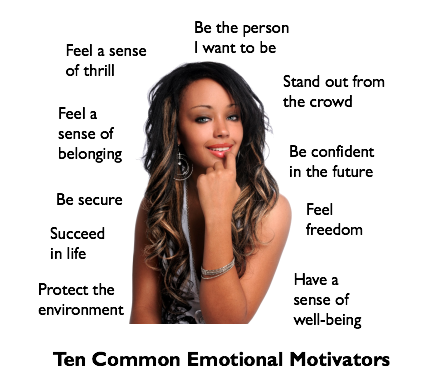
It is common knowledge that emotions are powerful drivers in the purchase decision process. Forging an emotional connection with customers can lead to big payoffs for companies. Consider this example: a major bank launched a credit card that emotionally connected well with Millennials, increasing use among this segment by 70% with 40% new accounts being opened. “The New Science Behind Customer Emotions,” published in Harvard Business Review, details research across hundreds of brands that uncovered ten common emotional motivators behind consumer behavior. Companies that understand their customers’ emotional connection to their brand and their emotional motivators generally will better attract and keep customers. While there are hundreds of potential emotional motivators, here are ten common emotional motivators:
Understanding the Specific Emotional Motivators in Your Product or Service Category
In order to make an emotional connection with potential users of your product or service, it is important to understand the distinct emotions in the context of when your product or service is used.
Conversations with potential users via qualitative research are a way to begin identifying the unique emotions in the context of when your product or service is used. It’s important to think about the chronology of events when examining the emotional motivators. Emotions change throughout the product usage experience. This type of understanding can occur through in-person interviews that occur in the context of when a product or service is used. Online qualitative research can also be a valid approach as respondents can discuss their thoughts and feelings via video taken in the context of a situation that they can upload for viewing. We have also used focus groups to gain this type of understanding through having participants complete pre-work assignments such as collages and diaries.
In designing research to uncover the emotions present in a situation, we always consider the following:
- What are some of the common feelings that are occurring before, during and after using a product or service?
- What are the common aspirations of users of the product or service?
- What are the positive emotions one wants to experience?
- What are the negative emotions one wants to avoid?
After a qualitative understanding of the common emotions is obtained, the prevalence of these emotions among the general population or specific target segments can be determined with quantitative research. Identifying the prevalent emotions can provide direction on how to communicate to potential users in order to form a stronger emotional connection.
Making an Emotional Connection in Your Advertising and Communications
In working with a client in the travel industry, we wanted to understand the emotions people want to experience when planning and taking a trip. To understand these emotions in this context, we had participants build collages that captured their thoughts and feelings when planning or taking a vacation. When thinking about travel, some of the more common emotions that one wants to experience are freedom, a sense of relaxation and bonding as one spends time with loved ones. The respondents’ visuals provided the client and their agency with direction in selecting the kinds of visuals that would resonate with consumers to use in their marketing communications. In addition, we were able to do laddering to understand what contributes to feeling a sense of freedom, relaxation and bonding. Identifying the elements, features or attributes that can produce the desired emotions is key to creating an appealing product or service experience.
Reinforcing that Emotional Connection in the Product Experience
Product and service developers can excel when they leverage the desired emotions in a given context to guide their design. An example of this comes from my work on the Puffs facial tissue brand. The most common context when facial tissues are being used is when someone is sick with a stuffy or runny nose. We all feel miserable when we’re sick, and wanting to feel comforted is one of the dominant emotional motivators. When blowing one’s nose, there is a desire to keep one’s hands dry. A thicker tissue provides more security that hands will stay dry. It was common to see people compensate for thinner tissues by folding them over before blowing their nose. Understanding the underlying emotional motivators of security and comfort drove our product design efforts. We explored innovations in materials to provide a thicker, more absorbent tissue that eliminated compensating behaviors resulting in a better experience. Learn more.
In summary, understanding the distinct emotional motivators in the context of your product or service can help you develop marketing communications that will resonate with your target audience and guide product or service design.
